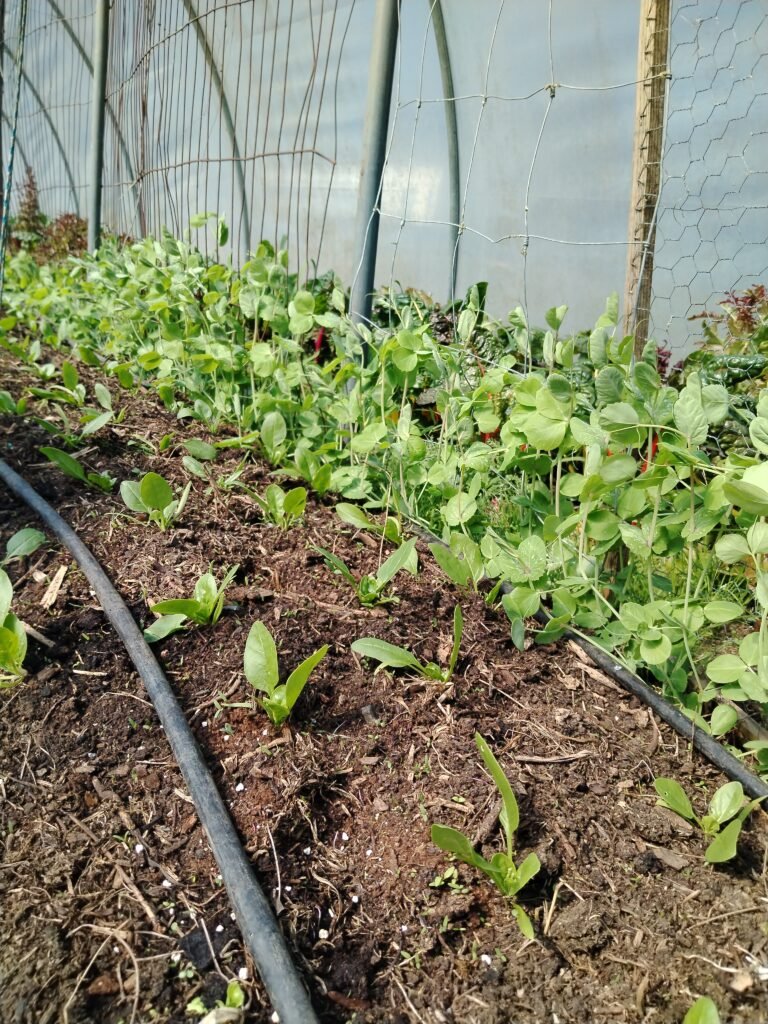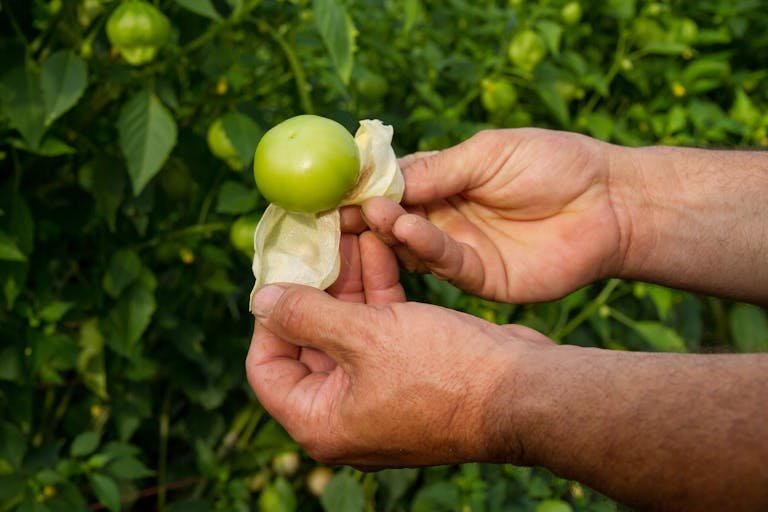

No rest for the wicked—or for gardeners, as it turns out. While January and February might seem like a quiet time in the garden, there’s plenty of work to be done, especially when it comes to using living mulch with leafy greens. That post-holiday lull is the perfect window to get the tunnels in order. Beds are cleared, compost is worked in, and everything gets covered and tucked up, ready for what’s next.
By the time mid-to-late February rolls around, the first spinach and lettuce are more than ready to move in. They go straight into those freshly prepped beds—not just as early crops for the kitchen, but as living mulch. It’s a simple, space-savvy way to keep the soil active, block out weeds, and gently improve structure while we wait for the main summer crops to catch up.
We grow in tight quarters, so most beds end up hosting more than one crop anyway. These early leafy greens make great placeholders, filling the gaps without getting in the way. And when the tomatoes, beans, and cucumbers are finally ready to go in, the greens either bow out gracefully—or keep on giving, quietly working alongside their taller companions.
It’s not fancy, but it works. And year after year, this little early-season ritual sets the tone for everything that follows.
What Is Living Mulch?
Living mulch is, quite simply, mulch that’s alive. Instead of covering your soil with straw, wood chips, or plastic, you use living plants to do the job—offering all the benefits of traditional mulch, with a few lovely extras. These plants, often low-growing and fast to establish, act as a living ground cover that protects the soil surface. They help regulate moisture, reduce erosion, improve structure, and suppress weeds naturally. But unlike a static layer of dead material, living mulch continues to grow, photosynthesise, and even contribute nutrients back into the soil. Some types—like legumes—can fix nitrogen. Others, like leafy greens, can be harvested before being cut back and dropped right where they grew, feeding the bed in the process. It’s a beautiful little system that mimics nature, where bare soil is rare and biodiversity rules the day.
In no-dig or low-disturbance gardening systems, living mulch fits in especially well. It keeps soil organisms happy, prevents compaction, and helps maintain the delicate balance underground. Best of all, you don’t have to wait until your garden is bursting at the seams to try it. In fact, living mulch is one of the easiest ways to make the most of the quieter months. While you’re waiting for your heat-loving crops to catch up, you can already be improving the soil and harvesting a few salad leaves along the way.
Think of it as a friendly placeholder. One that looks good, works hard, and fills your bowl while preparing your beds for whatever comes next.
Why Leafy Greens Are Perfect for the Job
When it comes to choosing plants for living mulch, leafy greens really shine. First of all, they’re fast growers. From the moment those seeds hit the soil, they’re off and running—giving you quick coverage just when the beds need it most. That’s especially helpful during the late winter and early spring, when the soil is waking up but summer crops are still weeks away from planting.
What makes them even better is their root system. Leafy greens like spinach and lettuce tend to have shallow roots, which means they won’t compete too heavily with your later plantings. Instead, they sit happily at the surface, helping to anchor the soil and hold moisture, while your tomatoes, cucumbers, or beans stretch deeper down once they move in. It’s a tidy little partnership.
Plus, they’re cold-tolerant, which makes them perfect for early planting in polytunnels or under cover. While other crops are still dreaming of warmer days, these hardy greens are getting on with it—turning empty beds into something productive and protective.
And let’s not forget the delicious bonus: you’re harvesting food while prepping your soil. A few handfuls of salad here and there add up quickly, especially when you’re not expecting much else from the garden yet. Then, when it’s time to transition to summer crops, they’re easy to clear—or better yet, you can simply chop and drop them in place to feed the soil with their leafy biomass.
In short, leafy greens tick all the boxes. They’re hardworking, space-efficient, and generous—making them a perfect fit for anyone looking to garden smarter, not harder, in those early months of the year.
Best Leafy Greens to Use as Living Mulch
Once you’ve decided to give leafy greens a go as living mulch, the next step is picking the right ones for your space and season. Luckily, there’s a whole parade of leafy lovelies that fit the bill—each with their own charm. Some are cold-hardy and ready to hit the soil while the winter chill still lingers. Others prefer the gentler touch of spring warmth. And then there are those extra-beneficial types that bring more than just foliage to the mix—offering pollinator support, pest confusion, or even subtle soil-cooling properties. Here’s a breakdown to help you choose the best companions for your garden beds:
Cold-Tolerant Stars (Great for Early Starts):
- Spinach – Quick to germinate, nutrient-dense, and a brilliant soil booster.
- Lettuce – Loose-leaf types work best; soft-rooted and lightning fast.
- Mizuna – Frilly and mild, tough enough to shrug off late frosts.
- Claytonia (Miner’s Lettuce) – Adorable edible leaves, perfect for shady spots.
Slightly Later Options (Mild Spring Weather):
- Chard – Can be cut young or left to grow tall for summer colour and cover.
- Pak Choi / Tatsoi – Cool-season champs; bolt quickly once heat arrives.
- Mustards – Peppery punch and gorgeous leaves in golds, purples, and greens.
- Rocket (Arugula) – Zips up fast, and flowers feed the bees if you let it go.
Bonus Beneficials:
- Coriander/Cilantro – Softens heat in the soil and buzzes with pollinators when it blooms.
- Parsley – A slow starter, but fills in gaps beautifully, especially in dappled shade.
- Basil – A warm-weather favourite that repels pests and pairs beautifully with tomatoes.
From Spring Greens to Summer Dreams: Companion Planting and Bed Transitioning
Now here’s where the real beauty of using leafy greens as living mulch comes into play—they’re wonderfully cooperative little workers. Most of them, like spinach, lettuce, and mizuna, are shallow-rooted, fast-growing, and polite enough not to interfere with the stars of summer. That means you can pair them with just about anything—tomatoes, cucumbers, French beans, squash—you name it. They don’t compete for nutrients, they don’t hog the space, and by the time your heat-lovers are stretching their legs, the leafy mulch has already done most of its job.
And when the time comes to make room, you don’t need to rip everything out in a flurry. Instead, it’s all about working with the plants, not against them. One of our favourite methods is the chop-and-drop. Just snip the greens at soil level, leaving the roots where they are. These break down gradually, feeding your soil with organic goodness while causing minimal disturbance to your underground ecosystem.
Then, you can mulch right over the stubble or top up with a bit of compost, depending on what you’ve got on hand. Seedlings can go straight into the gaps or right between rows if your greens are still growing and you want to stagger the transition.
It’s a gentle shift from one season to the next. No need to waste all that lush green growth—some of it goes to the kitchen, some to the compost, and the rest stays put as part of your soil’s living memory. It’s succession planting with soul—efficient, nourishing, and surprisingly beautiful when you step back and see it all working in harmony.
our Seasonal System: How I Do It (With Timeline)
There’s not much rest for the wicked—or the gardener, as it happens. While most folks are still coming down from the holiday madness, we’re already pottering about in the tunnels come January. It’s quiet, yes, but not idle. This is when we prep the beds—maybe a generous sprinkle of compost, maybe a bit of leaf mulch if there’s some left from autumn. Either way, it’s all about setting the stage without pressure.
By late February or early March, we’re sowing spinach and lettuce directly into those cozy, tunnel-protected beds. I tend to go for tried-and-true favourites like ‘Lollo Rossa’ and ‘Butterhead’ lettuces, and a hardy, deep green spinach like ‘Giant Winter’—all reliable, all fast. They spring to life quickly, covering the soil in a soft, edible blanket just when it needs it most.
Through March and April, those leafy greens do double duty. We harvest a bit here and there for fresh salads or a light stir-fry, all while they work beneath the surface—protecting, feeding, and sheltering our soil from the elements. They’re the quiet workers of the spring garden.
Then comes May and June, and everything shifts. As the warmth settles in and the light stretches longer into the evenings, we begin to tuck in the summer stars—tomatoes, cucumbers, French beans—right between the rows of greens. We trim the lettuces back if they get too bold, but often they gracefully bow out as the heat rises. The transition is soft and seamless, just the way I like it.
If I had a chalkboard in the garden, this would be the plan I’d sketch out year after year. It’s simple, satisfying, and it works.
Final Thoughts: A Green Start Worth Making
And just like that, you’ve got yourself a living mulch system that does more than just sit pretty. It’s functional, edible, and downright satisfying. While it may seem like a small act—tucking a few spinach and lettuce seeds into the soil in late winter—it sets the tone for the entire growing season. No bare beds, no wasted space, and no frantic last-minute planting once the warm weather hits.
Instead, you’re ahead of the game. Your soil is alive and well, your salad bowl is full, and your summer crops will thank you for the smooth handover. Plus, there’s a lovely rhythm to it—starting slow, gathering momentum, and letting one crop hand the baton to the next.
If you’re wondering which leafy to lead with, I always say start with spinach. It’s tough, generous, and just about foolproof when given a bit of cover and compost. Not sure where to begin? I’ve put together a full guide on How to Grow Spinach Like a Pro to help you get started.
So while the garden may look quiet on the surface, there’s a lot going on beneath. And you, dear gardener, are already one step ahead—without the stress, just the slow joy of doing things your way, season after season.
Here’s to beds that are always growing something, even in the hush of winter.






